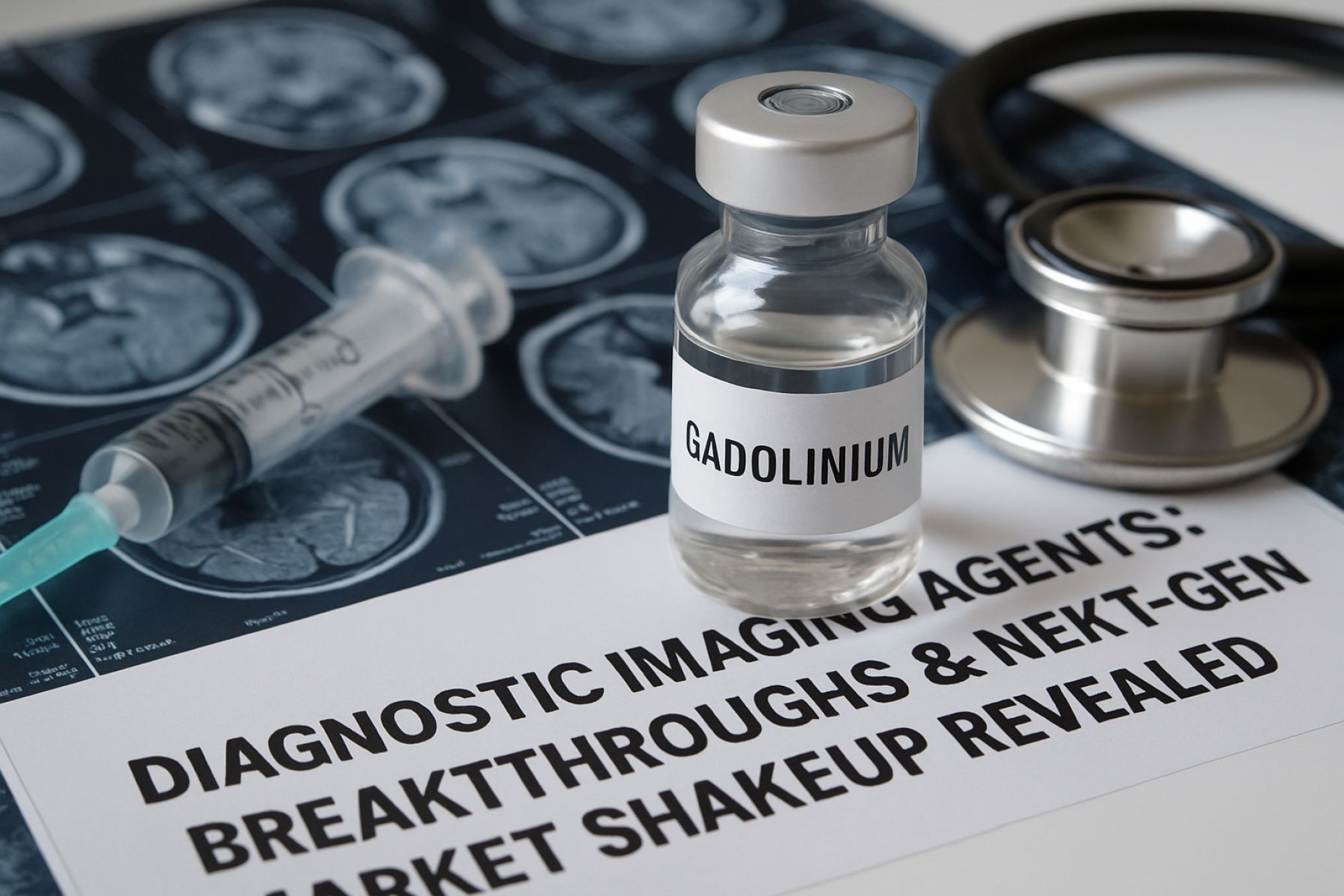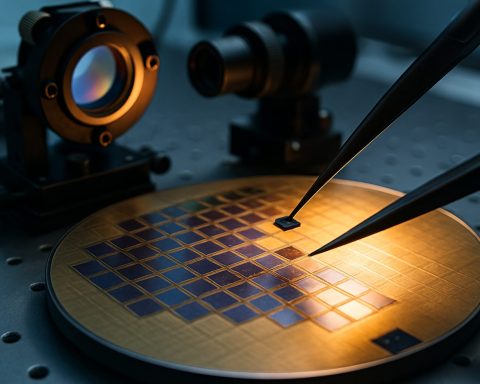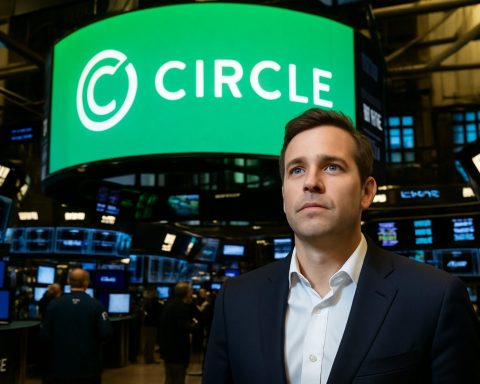Table of Contents
- Executive Summary: 2025 and Beyond
- Market Size & Growth Forecasts Through 2030
- Breakthroughs in Gadolinium-Based Contrast Agent Technologies
- Key Players & Strategic Developments (2025 Spotlight)
- Regulatory Landscape and Compliance Trends
- Emerging Applications in Precision Diagnostics
- Safety, Toxicology, and Next-Gen Formulations
- Regional Opportunities and Global Adoption Patterns
- Competitive Analysis: Innovation, M&A, and Partnerships
- Future Outlook: Disruptive Trends and Investment Hotspots
- Sources & References
Executive Summary: 2025 and Beyond
Gadolinium-labeled diagnostic imaging agents remain foundational in advancing medical imaging, particularly magnetic resonance imaging (MRI), and are anticipated to play a pivotal role in healthcare innovation through 2025 and the immediate years ahead. As of 2025, gadolinium-based contrast agents (GBCAs) constitute the majority of contrast-enhanced MRI procedures worldwide, supporting the diagnosis of neurological, cardiovascular, and oncological conditions. Major manufacturers, including GE HealthCare, Bayer AG, Bracco Imaging S.p.A., and Guerbet, continue to drive product development, regulatory compliance, and market availability in the sector.
Recent years have seen the introduction of new macrocyclic GBCAs, which offer improved safety profiles compared to earlier linear agents, addressing concerns over gadolinium retention in patients. For example, macrocyclic agents such as Gadavist® (gadobutrol) by Bayer AG and Dotarem® (gadoterate meglumine) by Guerbet have gained wider clinical preference due to their stability and reduced risk of nephrogenic systemic fibrosis (NSF). Regulatory agencies have continued to favor macrocyclic formulations, and leading suppliers have responded by expanding production and distribution capabilities.
The outlook for 2025 and beyond includes the development of next-generation gadolinium agents with improved pharmacokinetics and target specificity. Companies such as Bracco Imaging S.p.A. are actively investing in research to develop agents with lower dosages and higher tissue selectivity, aiming to enhance diagnostic accuracy while minimizing patient exposure. Additionally, the integration of artificial intelligence (AI) with MRI procedures is expected to optimize contrast agent utilization, potentially reducing the required dose and improving diagnostic workflows.
Environmental and safety considerations are shaping regulatory and industry actions, with increased emphasis on monitoring gadolinium discharge into water systems and enhancing collection protocols. In response, manufacturers like GE HealthCare and Guerbet are working to advance eco-friendly formulations and sustainability initiatives.
Overall, the period from 2025 onward is characterized by a strong commitment to innovation, safety, and environmental stewardship by leading industry players. The continued evolution of gadolinium-labeled imaging agents will be central to the progression of MRI diagnostics, with ongoing investments ensuring that new solutions meet emerging clinical, regulatory, and environmental demands.
Market Size & Growth Forecasts Through 2030
The market for gadolinium-labeled diagnostic imaging agents—primarily used as contrast agents in magnetic resonance imaging (MRI)—continues to demonstrate steady growth as of 2025, driven by increasing imaging procedure volumes, technological advancements, and expanding diagnostic applications. In 2024 and into 2025, global demand for MRI procedures remains robust, especially in oncology, neurology, and cardiovascular imaging, with gadolinium-based contrast agents (GBCAs) maintaining their status as the gold standard for enhanced visualization of internal structures.
Major manufacturers such as GE HealthCare, Bayer AG, and Guerbet continue to report sustained sales and investments in their GBCA product lines. For instance, Bayer’s Gadovist (gadobutrol) and GE HealthCare’s Clariscan (gadoteric acid) are widely adopted worldwide, with both companies expanding their presence in emerging markets and supporting clinical research into novel indications and improved safety profiles.
The global market size for gadolinium-labeled agents is expected to reach approximately $2.5–$3 billion (USD) by 2030, with a compound annual growth rate (CAGR) of around 4–5% during the forecast period. Growth is particularly pronounced in North America, Europe, and parts of Asia-Pacific, where investments in healthcare infrastructure and advanced diagnostic modalities are accelerating. According to Guerbet, the demand for contrast agents is not only coming from traditional hospital-based imaging but also from outpatient and ambulatory care settings, reflecting broader trends in healthcare delivery.
- Regulatory Developments: Post-2017, regulators such as the European Medicines Agency and U.S. FDA implemented stricter guidelines on linear GBCAs due to concerns over gadolinium retention. As of 2025, macrocyclic agents—which have a more stable chemical structure and lower risk of retention—dominate new product launches and hospital formularies (Bayer AG).
- Pipeline & Innovation: Several companies are focusing on next-generation agents with improved relaxivity, reduced dosing, and targeted imaging applications. Bracco Imaging and Guerbet are actively developing pipeline products and investing in research collaborations to expand market reach and address unmet clinical needs.
- Outlook: Looking to 2030, the market is anticipated to benefit from the rising global burden of chronic diseases, greater access to advanced imaging in developing regions, and continuing innovation in contrast agent chemistry and safety.
Overall, the gadolinium-labeled diagnostic imaging agent market is poised for continued, moderate expansion through 2030, supported by both established and emerging manufacturers, regulatory adaptation, and clinical demand for enhanced diagnostic tools.
Breakthroughs in Gadolinium-Based Contrast Agent Technologies
Gadolinium-based contrast agents (GBCAs) have remained a cornerstone in magnetic resonance imaging (MRI) diagnostics due to their superior ability to enhance tissue contrast. In 2025, the landscape of gadolinium-labeled diagnostic imaging agents is defined by significant advances in formulation safety, molecular targeting, and regulatory oversight, all aimed at improving diagnostic outcomes while minimizing patient risk.
A major breakthrough in recent years has been the development and deployment of macrocyclic GBCAs, which exhibit greater kinetic and thermodynamic stability compared to their linear counterparts. This enhanced stability reduces the risk of gadolinium ion release in vivo, thereby lowering the potential for nephrogenic systemic fibrosis (NSF) in vulnerable patient populations. Companies such as Guerbet and GE HealthCare have expanded their portfolio of macrocyclic agents, with products like Dotarem® (gadoterate meglumine) and Clariscan™ (gadoterate meglumine) increasingly being adopted globally in clinical practice.
Targeted gadolinium agents are another area of active innovation. These agents are being designed to bind specific biomarkers or pathological tissues, enhancing the specificity of MRI scans. For example, Bracco has invested in research partnerships to develop next-generation agents capable of targeting molecular signatures associated with oncological and neurological diseases. The increased specificity is expected to facilitate earlier and more accurate detection of diseases, particularly in oncology and neuroimaging.
Regulatory scrutiny and demand for safer agents have also driven the adoption of lower-dose formulations and agents with rapid renal clearance. Bayer continues to promote Gadovist® (gadobutrol), which is formulated to provide high relaxivity at lower doses, thus potentially reducing the total gadolinium exposure per examination.
Looking ahead, the next few years are likely to see further integration of artificial intelligence (AI) and MRI protocol optimization, allowing for ultra-low-dose contrast imaging without compromising diagnostic accuracy. Siemens Healthineers is collaborating with imaging centers to refine MRI sequences and AI algorithms that maximize signal-to-noise ratios when using gadolinium agents, paving the way for safer, more efficient imaging workflows.
As clinical guidelines evolve and more data accrue on long-term gadolinium retention, industry leaders are expected to prioritize transparency and post-market surveillance, ensuring that advancements in gadolinium-based technologies align with patient safety imperatives and evolving regulatory requirements.
Key Players & Strategic Developments (2025 Spotlight)
In 2025, the landscape of gadolinium-labeled diagnostic imaging agents is characterized by aggressive innovation, regulatory adaptation, and competitive positioning among leading pharmaceutical companies. Gadolinium-based contrast agents (GBCAs) remain essential in magnetic resonance imaging (MRI), underpinning clinical diagnostics in neurology, oncology, and cardiovascular medicine.
Key players dominating this sector include GE HealthCare, Bayer AG, Bracco Imaging S.p.A., and Guerbet. These companies are investing heavily in both product innovation and strategic partnerships, aiming to enhance safety, efficacy, and patient outcomes while addressing concerns regarding gadolinium retention and nephrogenic systemic fibrosis.
- GE HealthCare continues to expand its MRI contrast portfolio, with recent launches and ongoing clinical trials for macrocyclic agents that offer higher stability and reduced risk of gadolinium deposition. The company’s Clariscan is gaining traction in new markets, supported by ongoing post-marketing safety surveillance and pediatric indications (GE HealthCare).
- Bayer AG is advancing its gadobutrol-based agent, Gadovist, with regulatory filings in several emerging markets and further clinical validation for advanced imaging protocols, particularly in neuroimaging. Bayer’s strategic investments in digital imaging solutions are also fostering integration with artificial intelligence for enhanced image analysis (Bayer AG).
- Bracco Imaging S.p.A. is emphasizing environmentally responsible manufacturing and supply of its gadoteric acid-based agent, Gadovist (marketed globally as ProHance and MultiHance). The company has announced facility upgrades and new distribution agreements to meet growing global demand, particularly in North America and Asia-Pacific (Bracco Imaging S.p.A.).
- Guerbet is focusing on its macrocyclic agent, Dotarem, with expanded FDA and EMA indications, including pediatric use and specific applications in central nervous system imaging. Guerbet is also leveraging digital platforms to support radiologists with dosing and safety information in real time (Guerbet).
Looking ahead, the sector is expected to witness further consolidation, expanded clinical indications, and ongoing post-market surveillance to ensure long-term safety. Regulatory agencies are likely to tighten guidelines on gadolinium usage, prompting continued innovation for safer and more effective imaging agents.
Regulatory Landscape and Compliance Trends
The regulatory landscape for gadolinium-labeled diagnostic imaging agents continues to evolve in 2025, driven by heightened concerns about patient safety, environmental impact, and the need for standardized protocols across markets. In recent years, regulatory authorities have implemented stricter guidelines to address the risks associated with gadolinium retention in tissues and the environment, especially in patients with renal impairment.
In the United States, the U.S. Food and Drug Administration (FDA) has maintained updated labeling requirements for all gadolinium-based contrast agents (GBCAs), mandating warnings about potential gadolinium retention and recommending use at the lowest effective dose. The FDA’s focus remains on post-market surveillance and ongoing evaluation of safety data. In parallel, leading manufacturers such as GE HealthCare and Bayer AG continue to work closely with the FDA to provide periodic safety updates and comply with enhanced pharmacovigilance obligations.
In the European Union, the European Medicines Agency (EMA) has enforced the suspension of certain linear GBCAs and now strongly favors the use of macrocyclic agents, which exhibit lower propensity for gadolinium release and tissue retention. EMA guidelines for 2025 require comprehensive risk management plans from manufacturers, and periodic benefit-risk evaluations. Companies such as Guerbet and Bracco Imaging S.p.A. actively collaborate with regulatory bodies to ensure compliance and support the safe use of their products across Europe.
Environmental compliance has also come to the forefront, with agencies like EMA and the U.S. Environmental Protection Agency (EPA) scrutinizing the disposal and environmental fate of gadolinium compounds. Manufacturers are developing advanced formulations with improved kinetic and excretion profiles and supporting hospital-based initiatives for safe handling and waste management.
Looking ahead, industry experts anticipate further harmonization of international regulatory standards, particularly in light of new data emerging from ongoing clinical studies and long-term patient registries. The trend towards macrocyclic GBCAs is expected to continue, and both the FDA and EMA are evaluating new imaging agents with enhanced safety features. Manufacturers are investing in next-generation gadolinium agents and exploring alternative imaging technologies, while remaining vigilant to evolving regulatory requirements worldwide.
Emerging Applications in Precision Diagnostics
Gadolinium-labeled diagnostic imaging agents continue to play a pivotal role in the field of precision diagnostics, particularly as the demand for more targeted and safer imaging solutions grows in 2025 and beyond. Gadolinium-based contrast agents (GBCAs) are widely used in magnetic resonance imaging (MRI) due to their paramagnetic properties, which enhance image contrast and help in the early detection of various diseases, including cancer, neurological disorders, and cardiovascular conditions.
Recent years have seen a shift towards the development of next-generation gadolinium agents with improved safety profiles, especially in the context of concerns over gadolinium retention in body tissues. Leading manufacturers such as GE HealthCare, Bayer AG, and Bracco Imaging have focused on macrocyclic GBCAs, which are structurally more stable and less likely to release gadolinium ions compared to linear agents. In 2024 and 2025, products like Gadavist® (Bayer), ProHance® (Bracco), and Dotarem® (Guerbet) continue to gain market share, propelled by regulatory guidance favoring macrocyclic agents for enhanced patient safety.
Emerging precision diagnostic applications are driving innovation in gadolinium agent design. There is a growing focus on targeted GBCAs that can bind to specific biomarkers associated with tumors or vascular abnormalities, enabling earlier and more accurate disease characterization. Companies such as Bayer AG and Bracco Imaging are investing in research and clinical trials to develop agents with molecular targeting capabilities, aiming for approval in the next few years.
Another promising area is the integration of gadolinium-labeled agents with artificial intelligence (AI)-driven image analysis platforms. Collaborations between imaging agent manufacturers and technology firms aim to leverage AI for enhanced lesion detection and quantification, potentially improving diagnostic confidence and workflow efficiency. GE HealthCare has announced partnerships to integrate their MRI contrast agents with advanced imaging software, supporting the trend toward personalized and precision medicine.
Looking ahead, the regulatory landscape remains active, with agencies in the US and Europe continuing to tighten requirements on gadolinium safety monitoring. Manufacturers are responding with post-marketing surveillance studies and transparency initiatives regarding gadolinium deposition. The outlook for gadolinium-labeled diagnostic imaging agents is characterized by a continued emphasis on patient safety, targeted diagnostics, and technological integration—factors poised to shape innovation and adoption well into the late 2020s.
Safety, Toxicology, and Next-Gen Formulations
Gadolinium-labeled diagnostic imaging agents, primarily used as contrast enhancers for magnetic resonance imaging (MRI), remain a cornerstone in clinical imaging. However, safety and toxicological concerns—particularly related to gadolinium deposition and nephrogenic systemic fibrosis (NSF)—have driven both regulatory scrutiny and innovation in formulation as of 2025.
Current clinical practice is dominated by macrocyclic gadolinium-based contrast agents (GBCAs) due to their higher kinetic and thermodynamic stability compared to linear agents, which are associated with a higher risk of gadolinium retention in tissues. According to GE HealthCare and Bayer, their leading macrocyclic agents (such as Gadovist/Gadavist and Dotarem) continue to be widely used globally, with ongoing post-market surveillance confirming a favorable safety profile, particularly in patients with normal renal function.
Several manufacturers are investing in next-generation formulations to further mitigate risks. Guerbet is advancing its work on macrocyclic agents with proprietary formulations aiming for faster elimination and reduced tissue retention. In parallel, Bracco has announced research into agents with enhanced relaxivity, which could enable lower dosing and thus reduce total gadolinium exposure. These initiatives align with regulatory expectations set by agencies such as the U.S. FDA and the European Medicines Agency, which have updated recommendations to favor macrocyclic over linear GBCAs in most clinical situations.
Toxicology studies in 2024 and early 2025 have focused on long-term gadolinium retention, especially in populations requiring repeated imaging, such as pediatric or chronic disease patients. Both Bayer and Bracco report ongoing prospective registries and collaboration with academic centers to monitor real-world outcomes, emphasizing transparency and data sharing. No new major adverse effects have been identified in patients with normal renal function, but vigilance remains high, especially for at-risk populations.
Looking forward, the field is also exploring gadolinium alternatives and hybrid agents. Guerbet has initiated preclinical work on manganese-based agents, which may offer similar imaging benefits with a different safety profile. Such innovation is expected to shape the competitive landscape in the coming years.
In summary, while gadolinium-labeled agents remain essential for high-quality MRI diagnostics, the industry in 2025 is characterized by ongoing safety optimization, next-generation formulation development, and robust post-market surveillance, underpinned by close cooperation between manufacturers and regulatory bodies.
Regional Opportunities and Global Adoption Patterns
The global landscape for gadolinium-labeled diagnostic imaging agents continues to evolve rapidly in 2025, driven by technological advancements, shifting regulatory policies, and expanding healthcare infrastructures. North America remains a dominant market due to strong reimbursement systems, high diagnostic imaging adoption, and ongoing innovation by leading manufacturers such as GE HealthCare and Bracco. The United States, in particular, benefits from early regulatory approvals and the continuous introduction of new gadolinium-based contrast agents (GBCAs) for magnetic resonance imaging (MRI).
In Europe, increased awareness of gadolinium retention risks has led to the adoption of macrocyclic GBCAs, which are considered safer due to their lower propensity for releasing free gadolinium ions. The European Medicines Agency’s recommendations have shaped market preference, prompting manufacturers like Guerbet to emphasize macrocyclic agent production and promote newer formulations across the region. This regulatory-driven shift is anticipated to continue influencing purchasing decisions and clinical guidelines for the next several years.
Asia-Pacific is emerging as a significant growth region, propelled by investments in healthcare infrastructure and expanding MRI capacity in China, Japan, and India. Companies such as Canon Medical Systems and Shimadzu Corporation are accelerating local diagnostic capabilities by partnering with hospitals and government agencies to increase access to advanced imaging modalities. The region’s growing demand for non-invasive diagnostic solutions is expected to fuel further adoption of gadolinium-based agents, with localized R&D and manufacturing reducing costs and improving supply chain resilience.
Latin America and Africa, while lagging behind in terms of volume, are experiencing gradual growth as governments focus on modernizing healthcare services and improving diagnostic accuracy. Efforts by multinational corporations, including Bayer, to expand distribution networks and offer educational programs for radiologists are beginning to bear fruit. These initiatives are projected to incrementally increase access to high-quality imaging agents over the next few years.
Globally, the outlook for gadolinium-labeled diagnostic imaging agents in 2025 and beyond is characterized by rising demand for safer, more effective formulations, regional adaptation to regulatory shifts, and a broadening focus on underserved markets. Ongoing clinical research and post-market surveillance, led by industry stakeholders, will continue to shape adoption patterns and regional opportunities in the near future.
Competitive Analysis: Innovation, M&A, and Partnerships
The competitive landscape for gadolinium-labeled diagnostic imaging agents in 2025 is characterized by intensified innovation, a surge in mergers and acquisitions (M&A), and a growing number of strategic partnerships among pharmaceutical firms and imaging specialists. Major industry players are vying for market share by advancing both safety and efficacy profiles of their gadolinium-based contrast agents (GBCAs), as well as expanding clinical indications and geographic reach.
Innovation remains central, with leading manufacturers prioritizing the development of macrocyclic GBCAs due to their increased stability and lower risk of gadolinium retention in patients. Guerbet continues to invest in its Dotarem® (gadoterate meglumine) platform, recently launching label extensions for pediatric use and exploring novel formulations to minimize dose while maintaining diagnostic performance. Similarly, Bayer AG is expanding its Gadavist® (gadobutrol) franchise, seeking approval for new indications such as cardiac imaging and leveraging artificial intelligence to optimize dosing protocols.
M&A activity is accelerating as companies seek to broaden their portfolios and acquire proprietary technologies. In the past year, Bracco Imaging S.p.A. has completed the acquisition of select assets from smaller developers focused on next-generation GBCAs and targeted imaging agents, reinforcing its position in both North America and Asia-Pacific. There is also growing interest in developing gadolinium-based agents with theranostic capabilities, as seen in collaborations between established imaging firms and biotech innovators.
Partnerships are increasingly vital for advancing innovation and regulatory progress. For instance, GE HealthCare is working with academic institutions and contract research organizations to develop safer, more efficient imaging protocols and investigate long-term gadolinium deposition effects. Joint ventures are also being established to address global supply chain challenges and ensure the availability of high-quality raw materials and finished products.
Looking ahead, the outlook for gadolinium-labeled diagnostic imaging agents is shaped by ongoing regulatory scrutiny and a demand for agents with improved safety profiles. The industry is responding by investing in risk mitigation strategies, including the development of macrocyclic and lower-dose products, as well as enhanced post-market surveillance. As clinical and technological advances continue, the sector is expected to witness further consolidation and collaborative innovation, reinforcing the importance of partnerships and strategic acquisitions in shaping the market over the next several years.
Future Outlook: Disruptive Trends and Investment Hotspots
The landscape of gadolinium-labeled diagnostic imaging agents is poised for significant evolution in 2025 and the near future, driven by technological innovations, regulatory dynamics, and shifting investment priorities. Advances in molecular imaging and contrast agent chemistry are expanding the clinical utility and safety profile of gadolinium-based agents, with a strong emphasis on reducing risks associated with gadolinium retention and nephrogenic systemic fibrosis (NSF).
One disruptive trend is the development of macrocyclic gadolinium chelates, which demonstrate greater kinetic stability and lower propensity for gadolinium release compared to linear agents. Leading manufacturers such as GE HealthCare and Guerbet are actively promoting macrocyclic products like Dotarem® and Gadavist® (marketed by Bayer AG), reflecting a global shift away from linear agents. Regulatory agencies, including the U.S. Food and Drug Administration and the European Medicines Agency, have issued guidelines favoring macrocyclic agents for enhanced patient safety, influencing procurement decisions and pipeline development.
Another disruptive trend is the emergence of next-generation targeted gadolinium agents, designed for molecular imaging of specific disease biomarkers. For example, Bracco and academic-industry consortia are investing in novel agents that improve lesion detectability in oncology and neurology, potentially enabling earlier diagnosis and personalized therapy planning. The growing adoption of artificial intelligence in image analysis is further amplifying the clinical value of high-fidelity contrast enhancement, creating new opportunities for collaboration between imaging agent developers and digital health companies.
From an investment perspective, the gadolinium contrast agent segment continues to attract funding due to its central role in MRI diagnostics. Large-scale manufacturers such as Bayer AG, GE HealthCare, Guerbet, and Bracco are expanding production capacities and entering strategic partnerships to secure supply chains and accelerate product innovation. Emerging markets in Asia-Pacific are expected to experience above-average growth, driven by rising MRI procedure volumes, investments in healthcare infrastructure, and regulatory harmonization.
Looking ahead, the future of gadolinium-labeled imaging agents will be shaped by continued advances in agent safety, precision targeting, and digital integration. Investors are likely to focus on companies with differentiated portfolios, robust compliance practices, and the agility to respond to evolving clinical and regulatory standards.








